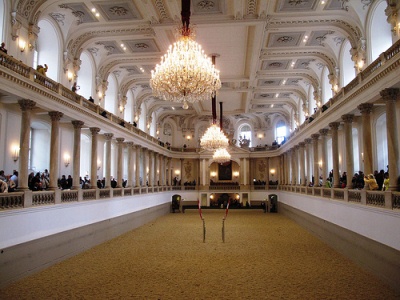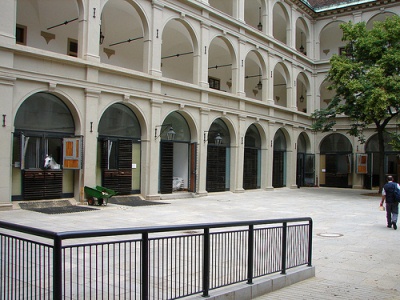

Tel. 01- 533 9031
Open: for performances
Closed: for public holidays

Winter Riding School or Spanish Riding School of Vienna was constructed in 1729- 35 under supervision of Josef Emanuel Fischer von Erlach. However the origins of the riding school date back to 1572 when Spanish Riding School was found in order to cultivate haute ecole horsemanship. First horses capable of dancing were brought from Span along with masters who took care of them. Under Habsburgs the Spanish Riding School or Spanische Reitschule flourished. Today you can see their routine by watching 80 minute show.
The institution that houses it is older than the
building. The “Spanish” in its name derives from the horse breed
native to the Iberian Peninsula, which proved to be particularly
capable of the classical art of riding.
At the end of the
15th and beginning of the 16th centuries, the high school was
reborn. It spread relatively quickly across Europe and found its
natural centers above all at the royal courts, where a venerable
chevaleresque tradition and a highly developed sense of the
ceremonial and ceremonial influenced school riding favorably. This
not only applies, but primarily to the Kaiserhof in Vienna, which
combined threads of its own kind with the Mediterranean region,
which is so important for classical equestrian art. One Habsburg
wore the crown of the Holy Roman Empire, another resided in Spain
and was at the same time Mr. Napoli, and between them and their
countries there was a constant exchange of goods of an ideal and
material, economic, cultural and also equestrian nature.
One
thing is important in the history of the Spanish Riding School.
During the reign of Joseph I and Charles VI, the “Reut-Schul” was a
natural facility and therefore not particularly worth mentioning.
The fact that she had been around for a long time and had wonderful
stallions was nothing unusual. Neither chief trainer nor stable
master in this century has published his teachings or has otherwise
been made public. There was no pluvinel or Löhneyßen, no Newcastle
or Solleysel at the Wiener Hof. Only the emperor and his chief
stable master represented the riding culture. The handwritten
"directives" of a superintendent only served the scholars for
training. No specialist pushed between the emperor and the subject
of his interest. Absolutism at the Vienna Court, unlike others,
prevented specialists from coming to the fore. Riding facilities
were a matter of course at all the aristocratic farms, and horse
washes were artistically designed. In the ruler's sphere of
influence, the stables and riding arena were placed on an equal
footing with the palace. The term "castle of the steed" was rightly
used.
Ferdinand I
Ferdinand I (1503–1564), who grew up in
Spain, stayed with his aunt and regent Margarete in Brussels and
Mechelen from 1518 to 1521 and came to Vienna in 1521, introduced
“Gineten” (Andalusian) in Prague and Vienna. He had stables built at
Prague and at Vienna Castle. For this, Ferdinand I also had a planta
de la traca de la cavalleriza, i.e. a plan for the construction of a
stable (riding stable), sent from Spain.
Ferdinand deployed
Spanish followers primarily in all areas related to horses, hunting
and animal breeding. Juan Maria (?), Of whom it cannot be said with
certainty whether he was a Spaniard, was commissioned by Ferdinand I
in 1533 to found a “Dutch” stud in Himberg. Juan Maria ran the
falcon farm, where Neapolitan horses were bred, until 1541. That
year Pedro de Rada, who was almost certainly a Spaniard, became the
new manager and ran it until his death in 1549. This stud farm
became 1543, maybe only temporarily moved to Podiebrad in Bohemia.
Neapolitans stood in Gahling (Máriakálnok) under the crown rule of
Hungarian-Altenburg Queen Mary (1538). The stud, which was moved to
Halbturn in 1540, was taken over in 1553 by Maximilian II, who later
moved to Mönchhof.
So Spaniards and Spanish horses were
significantly involved in horse breeding in Vienna. The horses of
the royal stable did not come exclusively from Spain. In Spain it
was not always possible to meet the high demand. Transport was
expensive and risky, and costs and food had to be taken care of
during the trip. It was cheaper to bring horses to Austria by land
and from nearby areas. It can be learned from various invoice
documents that "a number of Neapolitan pherdt money is to be
ordered". In addition to horses from Naples, Ferdinand I also had
“Turkish phardt” bought for the court in Vienna.
The cavalry also remained in Spanish hands for a
long time. This is borne out by names from later years such as Luis
Acarto, Antonio and Bartolomé Moreto and Juan de Salazar. Thus,
since the time of Ferdinand I, one can speak of a Habsburg Spanish
riding tradition, and not only from the 17th century. Pedro de Rada
was not only used as a rider, but also created a fish pond in
Himberg in 1549.
Maximilian II
Archduke Maximilian, son of
Emperor Ferdinand I, and then, from 1564, for over two decades,
himself lord and sire of the empire, also attempted regular
deliveries of Spanish horses from Vienna, be it from southern Italy
or from Spain himself. His personal horses were first in 1551 in
Vienna in Renngasse. The conversion of the stable castle, which was
built according to Spanish plans as a residence for Ferdinand I in
1560 but was never used as such, took place between 1565 and 1569.
Since then the Habsburgs' personal horses have been housed there.
First mentioned in 1565
In September 1565, a sum of money "to
erect Thumblplatz in the garden in Burg alhie" will be used. This
must be seen as the first mention of the later Spanish Riding
School. The year 1572, which has always been cited so far, as the
first recorded mention of the Spanish Riding School has to be
corrected to 1672. In addition, the source speaks of a "spanning" or
"spanish riding stable", not of a "riding hall". The institution is
therefore older than previously thought.
This Thumblplatz
extended on the site of today's Josefsplatz and its immediate
surroundings. On September 20 of this year, the Vizedom for Austria
under the Enns was ordered to pay a total of 100 guilders "to erect
Thumblplatz in the garden at Purgkh alhie". It was an open riding
and tournament track, which had to cause the need for a covered
riding school in bad weather. Another file, dated January 30, 1593,
talks about the harmfulness of the "Roß Dumbl Platz in the
Hoflustgarten" and demands: "So in addition to the choice (Wall) ain
stuckmaur, with 12 sleepers (fathoms) length and 5 sleepers high and
5 2 1/2 schuech dic Made, all Seulln at 6 schuch high are
underpinned ... ". The elongated and narrow Thumblplatz is probably
located in the city by the wall. Of course you couldn't make a lot
of state with him, after all he was better than nothing. He ensured
a more promising education in the sense of the high school, as this
could be possible outdoors. The horses frolicking there around 1593
included horses from Kladrub and Mönchhof (later Halbthurn) but no
horses from Lipica. In 1580 there was an event that had a
significant impact on the history of the imperial riding school,
when Archduke Karl of Inner Austria founded the Lipica farm stud.
But the horses from the Lipica stud farm were still bred exclusively
for the farm in Graz.
Leopold I
In 1641 and 1642 a
constructional combination of riding school and treasury was
considered. At that time, the court building clerk Frischhauser
calculated the construction of a treasury "with two arches over the
riding school at Tumblblaz" on 22,820 guilders and 22 cruisers. But
the project fell into the water, and it was only when Emperor
Leopold I ruled his inheritance and the empire that things began to
flow in terms of a permanent home that was closed on all sides for
the imperial riding school. Under this richly gifted Habsburg ruler,
not only was the foundation laid for the music and theater city of
Vienna, but also the magnificent carousels and those equestrial
performances that were already en vogue under the name of horse
ballets at Italian courts, but now shining in Leopoldine Vienna and
wasteful equipment have been far surpassed. Such a horse ballet was
shown on the inner Burgplatz on the occasion of the wedding of the
emperor to the Spanish infanta Margareta Theresia on January 24,
1667, and perhaps for the first time in Vienna human music was the
rhythm of the horses.
On August 20, 1672, the castle captain
of Ebersdorf was instructed "to have the imperial court Pau clerk at
their disposal, to be repaid by various standt Seyln (pillars) in
Spanish riding stables and a dozen and twenty other stamens (logs of
wood)". For the first time the expression Spanish Riding Stable
appears in this document.
More important than the open-mindedness for theatrical sensual pleasures, however, was that Emperor Leopold decided to have a new riding school built "in Vienna on Tumelplatz". Thus, on July 31, 1681 – almost exactly one hundred years after the foundation of the court stud in Lipica – the imperial order to the court paying office "to prosequirung of the bow on the Tumblplatz Alhier ended so the Made rollover after itself zusamben on 44.304 fl. 30 kr. to belauffen“. The act is accompanied by a letter from the court architect Johann Philipp Quenzer to the court chamber, from which it emerges that the old riding school on the Tummelplatz "had already completely perished". According to the estimate of 27 July 1681, which was also received, the new building was to be 46 fathoms long and 6 fathoms wide and have "two stöckh". The ground floor was intended for the riding school, while the first floor was devoted to the court library.